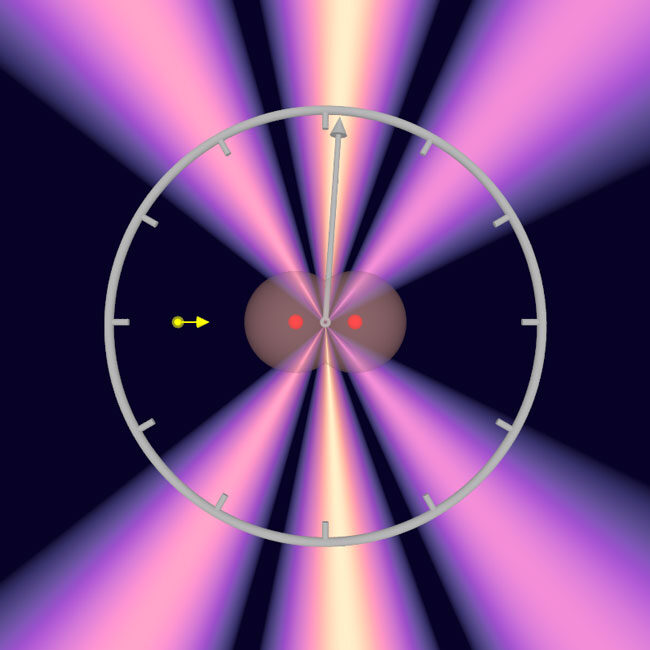
Now atomic physicists at Goethe University in Professor Reinhard Dörner's team have for the first time studied a process that is shorter than femtoseconds by magnitudes. They measured how long it takes for a photon to cross a hydrogen molecule: about 247 zeptoseconds for the average bond length of the molecule. This is the shortest timespan that has been successfully measured to date.
The scientists carried out the time measurement on a hydrogen molecule (H2) which they irradiated with X-rays from the synchrotron lightsource PETRA III at the Hamburg accelerator centre DESY. The researchers set the energy of the X-rays so that one photon was sufficient to eject both electrons out of the hydrogen molecule.
Electrons behave like particles and waves simultaneously, and therefore the ejection of the first electron resulted in electron waves launched first in the one, and then in the second hydrogen molecule atom in quick succession, with the waves merging.
The photon behaved here much like a flat pebble that is skimmed twice across the water: when a wave trough meets a wave crest, the waves of the first and second water contact cancel each other, resulting in what is called an interference pattern.
The scientists measured the interference pattern of the first ejected electron using the COLTRIMS reaction microscope, an apparatus that Dörner helped develop and which makes ultrafast reaction processes in atoms and molecules visible. Simultaneously with the interference pattern, the COLTRIMS reactions microscope also allowed the determination of the orientation of the hydrogen molecule. The researchers here took advantage of the fact that the second electron also left the hydrogen molecule, so that the remaining hydrogen nuclei flew apart and were detected.
"Since we knew the spatial orientation of the hydrogen molecule, we used the interference of the two electron waves to precisely calculate when the photon reached the first and when it reached the second hydrogen atom," explains Sven Grundmann whose doctoral dissertation forms the basis of the scientific article in Science. "And this is up to 247 zeptoseconds, depending on how far apart in the molecule the two atoms were from the perspective of light."
Professor Reinhard Dörner adds: "We observed for the first time that the electron shell in a molecule does not react to light everywhere at the same time. The time delay occurs because information within the molecule only spreads at the speed of light. With this finding we have extended our COLTRIMS technology to another application."
Publication:
Sven Grundmann, Daniel Trabert, Kilian Fehre, Nico Strenger, Andreas Pier, Leon Kaiser, Max Kircher, Miriam Weller, Sebastian Eckart, Lothar Ph. H. Schmidt, Florian Trinter, Till Jahnke, Markus S. Schöffler, Reinhard Dörner: Zeptosecond Birth Time Delay in Molecular Photoionization. Science https://science.sciencemag.org/cgi/doi/10.1126/science.abb9318



During an otherwise casual game of ball hockey with some friends, I had the biggest and most exuberant guy on the other team rushing in as I was I was goaltending, his team spreading out on his wing keeping pace with his rush. I'm keeping square to him and inching back careful of my net position as he gets into range.
Suddenly, instead of setting up a play he stops dead, plants and winds up a well-executed full body slapshot to the top middle, of the net. That is, directly at my unprotected goal-tending face from about 20 feet away. It's a laser straight shot but too fast to get anything up in front of my face so I start to brace myself and lean in, ready to take the relatively warmed up medium-hardness orange ball directly on the forehead.
I have a hard head and don't mind a bruise or scrape, and I was ready and confident I'd be fine, but something clicked in me just as my defense tried to turn and block the shot on the leg from about six or seven feet away and missed. I found myself having a serene, unhurried moment to think, in what I can only describe as Matrix-style bullet time, "Hey. That's going to leave a big red welt all day. I don't mind getting hit to save a goal but this seems a bit unreasonable. Oh, wait that's right! We said no slapshots and keep it below the shoulders. Hah! I don't have to save this."
In the last half a zeptosecond, I snaked my head around the ball as it zipped past, whipping my hair slighjtly with a whoosh and a thwap into the back of the net, just about the same time as everybody else, on both teams, was yelling at him for taking that shot and his arms going up stopped and came down, his expression quickly fading from elation to guilty embarassment.I just looked at him with exasperation and shook my head. "Really, Simon?"
Nothing more needed to be said, and everybody knew it meant no goal and our puck (ball). Without wasting another million zeptoseconds on it, I chipped the ball up to a forward who was already circling back put slowing politely for their last teammate to hustle until a couple of strides past center then played on..